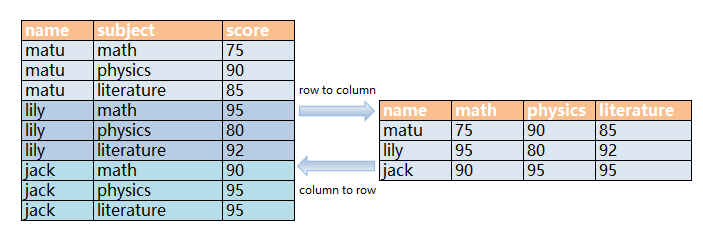How Does GaussDB(DWS) Implement Row-to-Column and Column-to-Row Conversion?¶
This section describes how to use SQL statements to convert rows to columns and convert columns to rows in GaussDB(DWS).
Scenario¶
Use a student score table as an example:
Teachers record the score of each subject of each student in a table, but students care only bout their own scores. A student needs to use row-to-column conversion to view their scores of all subjects. If the teacher of a subject wants to view the sores of all students of that subject, the teacher needs to use the column-to-row conversion.
The following figure shows the row-to-column and column-to-row conversion.

Figure 1 Diagram¶
Rows-to-column conversion
Convert multiple rows of data into one row, or convert one column of data into multiple columns.
Column-to-row conversion
Convert a row of data into multiple rows, or convert multiple columns of data into one column.
Example¶
Create a row-store table students_info, and insert data into the table.
CREATE TABLE students_info(name varchar(20),subject varchar(100),score bigint) distribute by hash(name); INSERT INTO students_info VALUES('lily','math',95); INSERT INTO students_info VALUES('lily','physics',80); INSERT INTO students_info VALUES('lily','literature',92); INSERT INTO students_info VALUES('matu','math',75); INSERT INTO students_info VALUES('matu','physics',90); INSERT INTO students_info VALUES('matu','literature',85); INSERT INTO students_info VALUES('jack','math',90); INSERT INTO students_info VALUES('jack','physics',95); INSERT INTO students_info VALUES('jack','literature',95);
View information about the students_info table.
SELECT * FROM students_info; name | subject | score ------+------------+------- matu | math | 75 matu | physics | 90 matu | literature | 85 lily | math | 95 lily | physics | 80 lily | literature | 92 jack | math | 90 jack | physics | 95 jack | literature | 95
Create a column-store table students_info1, and insert data into the table.
CREATE TABLE students_info1(name varchar(20), math bigint, physics bigint, literature bigint) with (orientation = column) distribute by hash(name); INSERT INTO students_info1 VALUES('lily',95,80,92); INSERT INTO students_info1 VALUES('matu',75,90,85); INSERT INTO students_info1 VALUES('jack',90,95,95);
View information about table students_info1.
SELECT * FROM students_info1; name | math | physics | literature ------+------+---------+------------ matu | 75 | 90 | 85 lily | 95 | 80 | 92 jack | 90 | 95 | 95 (3 rows)
Static row-to-column conversion¶
Static row-to-column conversion requires you to manually specify the column names using the given values. If no value is given to a column, the default value 0 is assigned to the column.
SELECT name,
sum(case when subject='math' then score else 0 end) as math,
sum(case when subject='physics' then score else 0 end) as physics,
sum(case when subject='literature' then score else 0 end) as literature FROM students_info GROUP BY name;
name | math | physics | literature
------+------+---------+------------
matu | 75 | 90 | 85
lily | 95 | 80 | 92
jack | 90 | 95 | 95
(3 rows)
Dynamic row-to-column conversion¶
For clusters of 8.1.2 or later, you can use GROUP_CONCAT to generate column-store statements.
SELECT group_concat(concat('sum(IF(subject = ''', subject, ''', score, 0)) AS "', name, '"'))FROM students_info;
group_concat
-----------------------------------------------------------------------------------------------------------------------------------------------------------------------------------------------------------------
-----------------------------------------------------------------------------------------------------------------------------------------------------------------------------------------------------------------
------------------------
sum(IF(subject = 'literature', score, 0)) AS "jack",sum(IF(subject = 'literature', score, 0)) AS "lily",sum(IF(subject = 'literature', score, 0)) AS "matu",sum(IF(subject = 'math', score, 0)) AS "jack",sum(IF
(subject = 'math', score, 0)) AS "lily",sum(IF(subject = 'math', score, 0)) AS "matu",sum(IF(subject = 'physics', score, 0)) AS "jack",sum(IF(subject = 'physics', score, 0)) AS "lily",sum(IF(subject = 'physics
', score, 0)) AS "matu"
(1 row)
In 8.1.1 and earlier versions, you can use LISTAGG to generate column-store statements.
SELECT listagg(concat('sum(case when subject = ''', subject, ''' then score else 0 end) AS "', subject, '"'),',') within GROUP(ORDER BY 1)FROM (select distinct subject from students_info);
listagg
-----------------------------------------------------------------------------------------------------------------------------------------------------------------------------------------------------------------
--
sum(case when subject = 'literature' then score else 0 end) AS "literature",sum(case when subject = 'physics' then score else 0 end) AS "physics",sum(case when subject = 'math' then score else 0 end) AS "math
"
(1 row)
Dynamically rebuild the view:
CREATE OR REPLACE FUNCTION build_view()
RETURNS VOID
LANGUAGE plpgsql
AS $$ DECLARE
sql text;
rec record;
BEGIN
sql := 'select LISTAGG(
CONCAT( ''sum(case when subject = '''''', subject, '''''' then score else 0 end) AS "'', subject, ''"'' )
,'','' ) within group(order by 1) from (select distinct subject from students_info);';
EXECUTE sql INTO rec;
sql := 'drop view if exists get_score';
EXECUTE sql;
sql := 'create view get_score as select name, ' || rec.LISTAGG || ' from students_info group by name';
EXECUTE sql;
END$$;
Rebuild the database:
CALL build_view();
Query view:
SELECT * FROM get_score;
name | literature | physics | math
------+------------+---------+------
matu | 85 | 90 | 75
lily | 92 | 80 | 95
jack | 95 | 95 | 90
(3 rows)
Column-to-Row Conversion¶
Use UNION ALL to merge subjects (math, physics, and literature) into one column. The following is an example:
SELECT * FROM
(
SELECT name, 'math' AS subject, math AS score FROM students_info1
union all
SELECT name, 'physics' AS subject, physics AS score FROM students_info1
union all
SELECT name, 'literature' AS subject, literature AS score FROM students_info1
)
order by name;
name | subject | score
------+------------+-------
jack | math | 90
jack | physics | 95
jack | literature | 95
lily | math | 95
lily | physics | 80
lily | literature | 92
matu | math | 75
matu | physics | 90
matu | literature | 85
(9 rows)